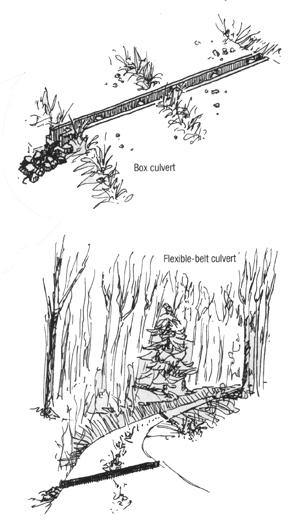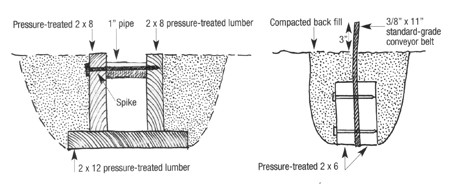The woods road’s worst enemy is water. It makes travel difficult, and if it’s not diverted, rainwater can wash away a road surface in a single summer storm.
You can avoid problems like this through the installation of simple water-diversion structures. If your road has stretches of continuous slope where water can pick up energy and do damage, you can use open-topped culverts and the flexible-belt structure described below to move water off the road surface and into the undisturbed forest floor, where it will be dispersed and absorbed.

An open-topped culvert, box culvert, or “Thank You Ma’am” will drain the road without impeding access. Nail two 2 x 8 pressure-treated boards to a 2 x 12 base, approximately 3 3/4 inches apart. Insert a spacer every 4 feet using a section of one-inch pipe, and drive a spike through each pipe. Bury the structure in the road surface so that the top of the 2 x 8s is level with the road surface, and then carefully compact the soil around the box culvert. The structure should be aligned so that it is at a 30- to 45-degree angle to a line perpendicular to the centerline of the road, and the outlet end, obviously, should be lower than the opposite end. Fill the area below the outlet with stones to act as riprap. If properly installed, open-topped culverts will be self-cleaning, but they should be regularly inspected to make sure they are operating properly.
Here’s an even simpler device that will divert water while allowing you to continue to use the road, with the added advantage of requiring little or no maintenance. All you need is a 3/8-inch x 11-inch standard-grade rubber conveyor belt. These can sometimes be salvaged by visiting a stone quarry or gravel pit or purchased from a manufacturer. For a good source for belt manufacturers, where you may be able to pick up some rejects, click here. (Search under Material Handling and then Belting. There are several dozen listed there.) Secure the belt between two pressure-treated 2 x 6s so that 6 inches of the belt is exposed above the boards. Then set the belt sandwich into a trench cut into the road so that at least 3 inches of belt is exposed above the road surface. Fill in the hole and compact it. This structure should be placed with at least a 10-degree angle to the centerline of the road, and the outfall should be filled with riprap to avoid undercutting the road.
Be sure to install enough diversions to protect long grades. The farther the water can travel on the road, the more destructive energy it will accumulate. The proper distance between diversions depends upon the slope and the soil’s potential for erosion. As a rule of thumb, they should be placed 125-150 feet apart on a five-percent slope (the equivalent of a 5-foot rise or fall in elevation over 100 feet of road), while on a 10-percent grade, they should be only 75-100 feet apart.
A good road makes a good woodlot. Whether your woods are used for hiking, hunting, or harvesting, keeping soil from washing away is essential.


